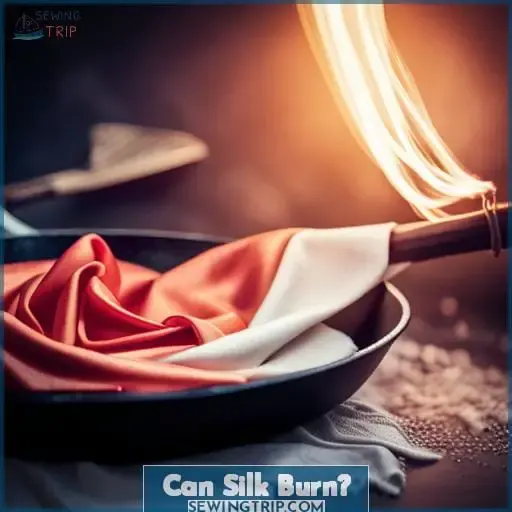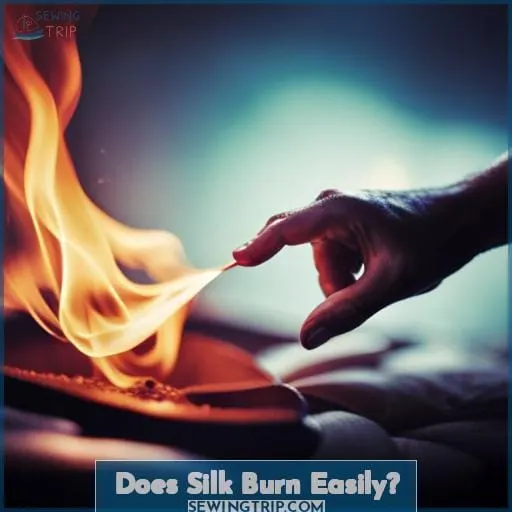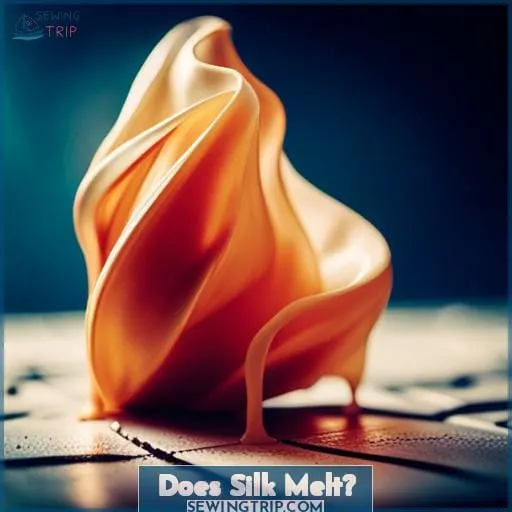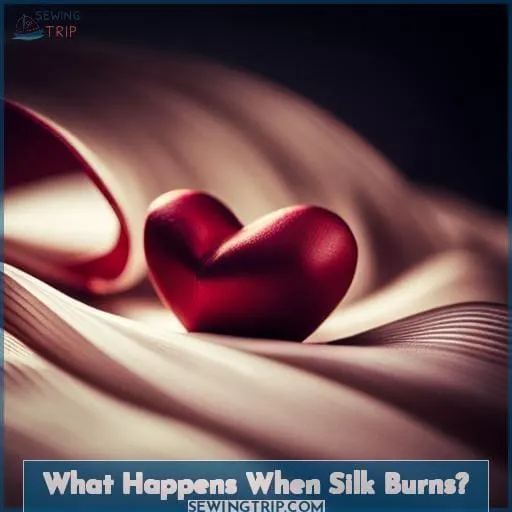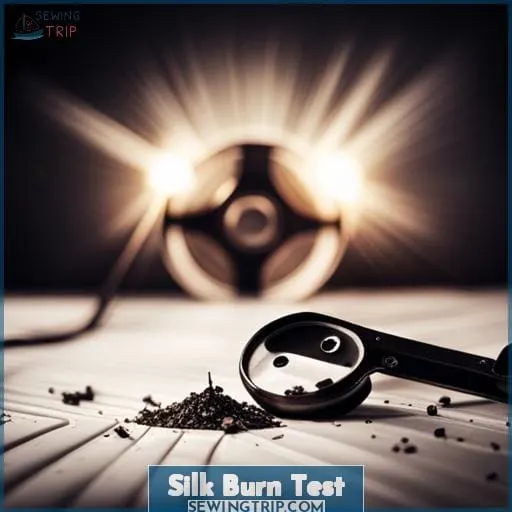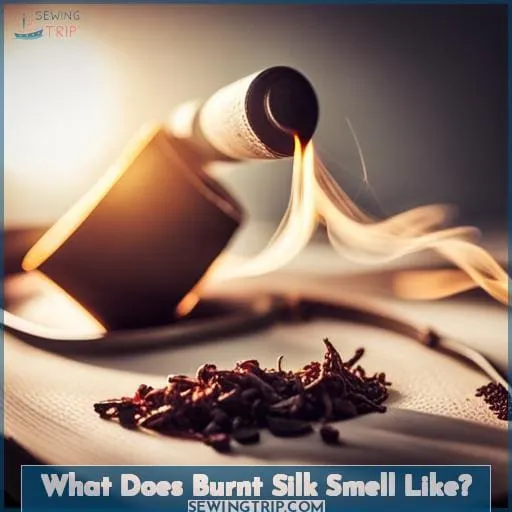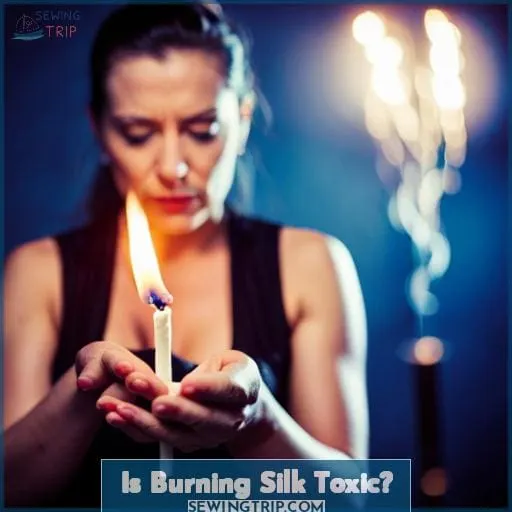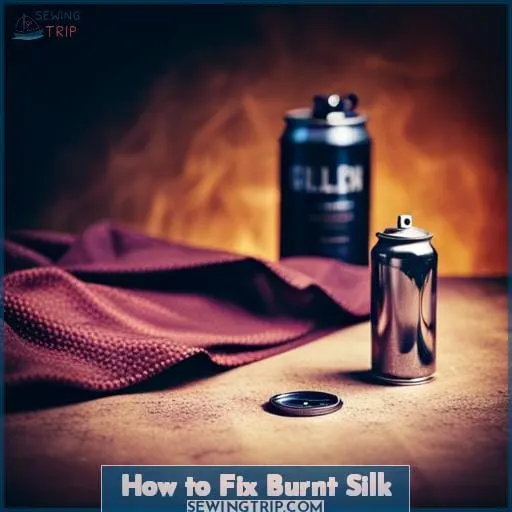This site is supported by our readers. We may earn a commission, at no cost to you, if you purchase through links.
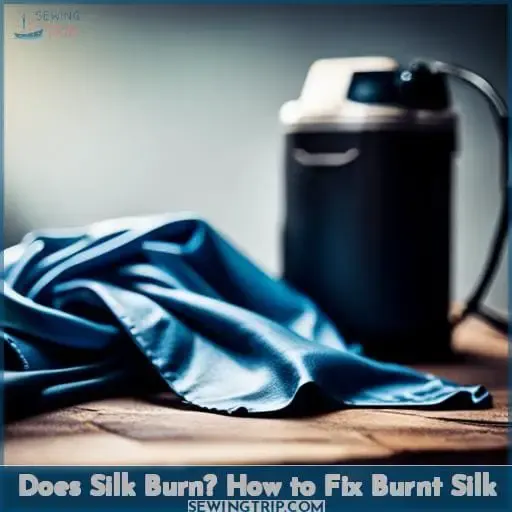 Imagine the thrill of wearing a luxurious silk garment, only to have it accidentally catch fire. Don’t panic! In this article, we’ll explore whether silk burns and how you can fix burnt silk.
Imagine the thrill of wearing a luxurious silk garment, only to have it accidentally catch fire. Don’t panic! In this article, we’ll explore whether silk burns and how you can fix burnt silk.
You’ll discover that while silk does burn, it doesn’t melt like other fabrics. We’ll also share tips on identifying burnt-silk smells and temperatures at which it ignites. Plus, we’ll reveal effective techniques for repairing burned holes in your precious silk garments.
Get ready to rescue your favorite silken pieces with our expert advice!
Table Of Contents
Key Takeaways
- Silk can burn under certain conditions, but it does not melt like synthetic fabrics.
- The temperature at which silk burns can vary depending on factors such as weave density and chemical additives in dyeing processes.
- Silk tends to have moderate combustibility compared to other natural fibers.
- When conducting a silk burn test, observe the ignition speed, whether it continues to burn after removal from the flame, any distinct smell emitted during combustion, and the burnt remains for analysis.
Can Silk Burn?
Silk can burn under certain conditions. As a textile engineer, fashion designer, or fabric care specialist, it’s important to understand how silk behaves when exposed to fire. Conducting a silk burn test can provide valuable insights into the burning properties of this luxurious fabric.
When performing a silk burn test, observe:
- How quickly the fabric ignites
- Whether it continues to burn after being removed from the flame
- Any distinct smell emitted during combustion
- The burnt remains for further analysis
The temperature at which silk burns will vary depending on several factors such as its weave density and chemical additives used in dyeing processes. It’s crucial to consider these variables when determining safe handling procedures for working with silk fabrics near open flames.
In terms of burning rate, pure silk tends to have moderate combustibility compared to other natural fibers like cotton or linen. While synthetic fibers may melt under high heat exposure, causing severe damage and potential harm due to dripping molten material onto skin or surfaces nearby; Silk has self-extinguishing properties that prevent rapid spreading of flames once ignited.
Furthermore, silk doesn’t emit toxic fumes when burned but rather produces an aroma reminiscent of burnt feathers or meat. The bead-like residue left behind after burning can be easily cleaned off without leaving permanent damage on your garment.
Understanding how Silk reacts in different situations empowers you with knowledge about proper care practices while also ensuring your safety around potential fire hazards.
Does Silk Burn Easily?
When it comes to the flammability of silk, you’ll want to know if this luxurious fabric burns easily.
- Silk Burns Quickly:
- Silk has a high burning rate, which means it can ignite and spread rapidly when exposed to flames.
- It’s important to exercise caution around open flames or heat sources when wearing or working with silk garments.
- Silk Burns Hot:
- When silk catches fire, it burns at a high temperature.
- This means that any contact with the burning material can cause severe burns and damage.
- Silk Burn Test Results:
- Smell: Burning silk emits an odor similar to burnt hair or feathers.
- Beads Formation:The burnt remains of burned silk will form beads-like residue that might be left behind on the fabric after extinguishing the flame.
- Quick Ignition and Continued Burning: Pure silk ignites quickly under direct flame exposure but self-extinguishes once removed from the source.
It’s essential always practice proper safety precautions around open flames while wearing 100% pure silks garments as they burn easily compared synthetic fabrics like nylon or polyester.The use of protective clothing such as aprons made from natural fibers (e.g., cotton) in situations where sparks may fly is also recommended.
Does Silk Melt?
If you expose silk to high heat, it will melt rather than burn. Silk is a delicate fabric that can easily be damaged by excessive heat. When subjected to intense heat, the silk fibers begin to shrink away from the flame and appear as if they’re melting.
However, unlike synthetic fabrics that leave behind a hard plastic-like residue when melted, burnt silk doesn’t produce any visible color or residue.
When conducting a silk burn test, you may notice that the material curls up as it burns and emits a smell similar to burning hair or feathers. This distinct odor is characteristic of natural animal fibers such as silk. The burned remains of pure silk will be in the form of small dark beads.
It’s important to note that while burning or melting can cause damage to your precious silks garments, they don’t pose significant safety risks like some other materials do when exposed to high temperatures.
If your silky attire gets accidentally burned or melted due to mishaps during ironing or contact with hot objects like candles; don’t worry! You can fix minor damages using simple techniques such as trimming off any charred edges with sharp scissors and carefully removing any residual bead-like remains left on the fabric surface.
Remember always take precautions around open flames and avoid exposing your beloved silks items unnecessarily at high-risk areas where accidents could occur inadvertently leading them towards fire hazards.
What Happens When Silk Burns?
As you hold silk against a flame, it undergoes a process known as combustion.
When silk burns, it doesn’t melt like synthetic fabrics; instead, it shrinks away from the flame and curls up. The burning of silk is invisible, so you won’t see any color as the fabric turns to smoke.
However, after the fire extinguishes itself or is put out by removing the fabric from the flame source, you may notice burnt edges or marks on your silk garment.
The residue left behind when silk burns is in the form of dark beads that can be easily removed from your clothing item. Unlike other materials that leave behind ash-like remnants when burned, pure burnt Silk leaves these hard beads which can be crushed into powder between your fingers.
In terms of smell when burning Silk garments will produce an aroma similar to burnt meat or feathers due to its natural fiber composition.
It’s important to prioritize safety while dealing with burnt Silk items and avoid direct contact with flames whenever possible!
Silk Burn Test
To determine if your silk garment is made from pure silk, you can perform a burn test. This test involves carefully holding a small square of the fabric in the flame of a lighter or candle and observing how it reacts to fire.
The results of the burn test will provide valuable information about the composition of your fabric.
When conducting a silk burn test, it’s important to prioritize safety. Make sure to have proper ventilation and keep flammable materials away from the testing area. Use tweezers or tongs to hold the fabric sample and avoid touching it with bare hands.
As you hold the fabric in the flame, pay attention to how quickly it ignites, whether it chars or melts, what odor is emitted, if it continues burning after removed from flame,and what remains are visible once burned.
The results may vary depending on different types offibres but generally speaking,pure silk shouldn’t ignite easilyand tends todissolve intoa dark bead that can be easilyremoved.
Remember that this method has its limitations when dealing with mixed fibre fabrics as they may display varying reactions within one swatch.
Performinga silkburntestis an effective wayto identifythe typeoffibreinyourfabric.
What Temperature Does Silk Burn?
Silk burns at a temperature high enough to ignite the fabric. Understanding the temperature at which silk burns is crucial for handling and caring for this delicate material.
- Silk begins to burn around 400 degrees Fahrenheit (or 212 degrees Celsius). This is considered its ignition point, where it starts to catch fire.
- As the heat increases, so does the rate of burning. At around 500 degrees Fahrenheit (or 475 degrees Celsius), silk will burn more rapidly.
- It’s important to note that different factors such as weave, thickness, and additional treatments like dyes or flame retardants may affect these temperatures slightly.
Knowing these temperatures can help you take better care of your silk garments or fabrics. By avoiding exposure to open flames or excessive heat sources beyond these thresholds, you can prevent accidental damage caused by burning.
In case your silk does get burnt accidentally, don’t worry! There are ways to fix burnt areas on your beloved pieces without compromising their beauty and functionality. In our next section, we’ll explore effective methods for repairing burnt silk garments so that you can enjoy them again with confidence and style.
What Does Burnt Silk Smell Like?
When you burn silk, it emits a distinct odor reminiscent of burnt chicken feathers. The smell is unique and can be easily identified if you’re familiar with the scent of burning hair or feathers. It has been described by some as a combination of burnt meat and paper, while others may detect hints of burnt plastic in the air.
This characteristic smell is due to the natural composition of silk fibers and their reaction when exposed to heat or flame.
As a textile engineer, fashion designer, or fabric care specialist, understanding what burnt silk smells like can help you identify any damage that may have occurred to your delicate garments. If you accidentally scorch your silk clothing with an iron or encounter any other burning mishap, being able to recognize this specific odor will alert you to take immediate action in order to prevent further damage.
Remember that burned silk should always be treated delicately once extinguished as it leaves behind dark beads on the fabric’s surface. However unpleasant its scent might be when burned, proper care and repair techniques can often salvage garments made from this luxurious material without compromising their quality or beauty.
How Fast Does Silk Burn?
The speed of silk combustion is influenced by various factors.
When it comes to the burning rate of silk, there are a few things to consider:
- Silk has a relatively fast burning rate compared to other fabrics.
- The exact time it takes for silk to burn will depend on the specific conditions, such as the flame’s intensity and duration.
- The temperature at which silk burns can vary but is generally around 1800°F (982°C).
- When silk burns, it emits a distinct odor that can be described as similar to burnt hair or feathers.
- It’s important to note that while silk can burn quickly, it typically doesn’t continue burning once removed from the flame.
Understanding how fast silk burns is crucial in preventing accidents and potential hazards. As someone interested in textiles or fashion design, being aware of this information allows you to make informed decisions when working with or wearing garments made from this luxurious fabric.
By understanding its properties and handling them responsibly, you can enjoy both freedom of style expression and peace of mind regarding safety precautions.
Is Burning Silk Toxic?
Burning silk can release toxic fumes, posing potential health risks to you and those around you. However, the good news is that silk itself isn’t toxic or hazardous when it burns. Unlike some synthetic fabrics, silk doesn’t emit toxic fumes or pose any health risks.
To further emphasize this point, let’s take a look at a comparison table:
| Fabric Type | Toxic Fumes | Health Risks |
|---|---|---|
| Silk | No | No |
| Polyester | Yes | Yes |
As you can see from the table above, burning silk doesn’t produce any toxic fumes and therefore doesn’t present any health risks. This makes it a safer choice compared to fabrics like polyester which do emit harmful substances when burned.
So if your silk garment accidentally catches fire or gets burnt in some way, there’s no need to panic about inhaling dangerous toxins. While it’s always important to handle fires with caution and prioritize safety measures such as extinguishing flames quickly and seeking medical attention if necessary after an incident involving burning fabric – rest assured that burnt silk alone won’t introduce additional toxicity into the air.
Remember though – prevention is key! Take proper precautions while handling open flames near delicate fabrics like silks to avoid accidents altogether.
How to Fix Burnt Silk
To fix burnt silk, you can try using a professional fabric repair kit or take it to a skilled tailor for repairs.
- Use ice cubes: Gently rub an ice cube over the burnt area to cool and harden any melted fibers. This may make it easier to remove the damaged portion without causing further damage.
- Hairspray: Spray hairspray onto a clean cloth and gently dab at the burned area. The alcohol content in hairspray may help lift off some of the scorch marks.
- White vinegar: Mix equal parts white vinegar and water, then use a soft cloth soaked in this solution to blot at the burn mark. Vinegar is known for its stain removal properties and may help lighten or eliminate discoloration caused by burning.
- Baking soda paste: Make a thick paste using baking soda mixed with water and apply it directly onto the burned spot. Let it sit for several hours before brushing away gently with a soft brush or cloth.
- Nail polish remover (acetone-free): Dampen a cotton ball with acetone-free nail polish remover and carefully blot at the affected area. Be cautious not to saturate your silk garment as excessive moisture could cause more damage.
Remember that these methods can’t guarantee complete restoration of your burnt silk garment but they might improve its appearance significantly enough so that you can continue wearing it confidently!
Frequently Asked Questions (FAQs)
How can you determine if a fabric is made of pure silk?
To determine if a fabric is pure silk, use tweezers to protect your fingers and hold a thread against a flame.
If it shrinks away and smells like burnt chicken feathers, you may have pure silk.
What does burnt silk smell like?
When silk burns, it emits a distinctive smell reminiscent of burnt chicken feathers. This scent is a telltale sign that your fabric is made of pure silk, allowing you to identify and care for it accordingly.
Is burning silk toxic?
Burning silk releases toxic fumes, posing a danger to your health.
The flames may not fully consume the fabric but can leave holes behind.
Seek professional help to fix any damage caused by fire.
How fast does silk burn?
Silk burns slowly, requiring a constant flame to thoroughly ignite. It doesn’t melt but shrinks away from the fire, leaving behind a dark bead residue.
What is the best way to fix burnt silk?
When it comes to fixing burnt silk, remember the adage where there’s a will, there’s a way. While it may be challenging, consult with a professional fabric care specialist who can skillfully repair your precious garment.
Conclusion
To sum it up, silk does burn but it doesn’t melt like other fabrics.
When silk burns, it creates a distinctive smell and leaves behind burnt holes.
The temperature at which silk ignites is relatively low compared to other materials.
However, burning silk isn’t toxic.
If you find yourself with burnt silk, don’t worry! There are effective techniques for repairing the damage and salvaging your luxurious garments.
So, go ahead and fix your burnt silk with confidence!

